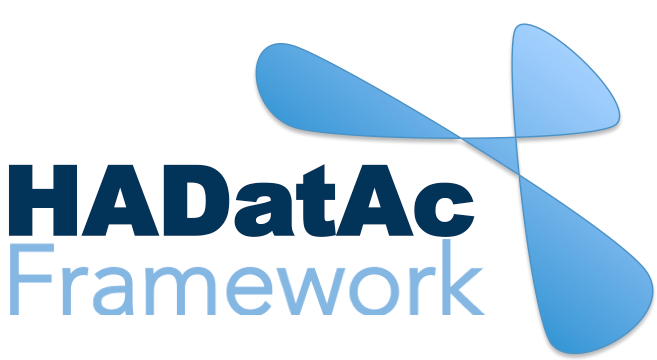-
Notifications
You must be signed in to change notification settings - Fork 24
Home
A significant amount of time and effort is often spent organizing data before their meaning can be understood, thus enabling one to analyze the data and to infer new knowledge from them. HADatAc is an infrastructure that enables combined collections of data and metadata in a way that metadata is properly and logically connected to data. By data (and metadata) collection we mean the process of identifying data sources, interacting with these sources to move the data from their transient state into a persistent repository, and to enable the data to be retrieved from their persistent repositories through the use of queries. HADatAc data is composed of scientific measurements in support of empirical scientific activities and/or computer-generated results of model simulations in support of computational scientific activities. HADatAc metadata is a rich collection of contextual knowledge about scientific activities encoded and connected to the data through the use of semantic web technologies. This rich metadata collection is thus leveraged by the HADatAc infrastructure to support the following: data management; data governance in terms of privacy, access and dissemination; uncertainty management; and (big) data analytics.
- To understand how to contribute and manage data/metadata in HADatAc , visit HADatAC's Data Owner Guide
- To understand how to install and setup HADatAc, visit HADatAc's System Admin Guide
- To understand how the code is organized, visit HADatAc's Developer Guide
Enjoy!
HADatAc.org Team
Copyright (c) 2019, HADatAc.org

-
Installation
1.1. Installing for Linux (Production)
1.2. Installing for Linux (Development)
1.3. Installing for MacOS (Development)
1.4. Deploying with Docker (Production)
1.5. Deploying with Docker (Development)
1.6. Installing for Vagrant under Windows
1.7. Upgrading
1.8. Starting HADatAc
1.9. Stopping HADatAc -
Setting Up
2.1. Software Configuration
2.2. Knowledge Graph Bootstrap
2.2.1. Knowledge Graph
2.2.2. Bootstrap without Labkey
2.2.3. Bootstrap with Labkey
2.3. Config Verification -
Using HADatAc
3.1. Initial Page
3.1.1. Home Button
3.1.2. Sandbox Mode Button
3.2. File Ingestion
3.2.1. Ingesting Study Content
3.2.2. Manual Submission of Files
3.2.3. Automatic Submission of Files
3.2.4. Data File Operations
3.3. Manage Working Files 3.3.1. [Create Empty Semantic File from Template]
3.3.2. SDD Editor
3.3.3. DD Editor
3.4. Manage Metadata
3.4.1. Manage Instrument Infrastructure
3.4.2. Manage Deployments 3.4.3. Manage Studies
3.4.4. [Manage Object Collections]
3.4.5. Manage Streams
3.4.6. Manage Semantic Data Dictionaries
3.4.7. Manage Indicators
3.5. Data Search
3.5.1. Data Faceted Search
3.5.2. Data Spatial Search
3.6. Metadata Browser and Search
3.7. Knowledge Graph Browser
3.8. API
3.9. Data Download -
Software Architecture
4.1. Software Components
4.2. The Human-Aware Science Ontology (HAScO) -
Metadata Files
5.1. Deployment Specification (DPL)
5.2. Study Specification (STD)
5.3. Semantic Study Design (SSD)
5.4. Semantic Data Dictionary (SDD)
5.5. Stream Specification (STR) -
Content Evolution
6.1. Namespace List Update
6.2. Ontology Update
6.3. [DPL Update]
6.4. [SSD Update]
6.5. SDD Update -
Data Governance
7.1. Access Network
7.2. User Status, Categories and Access Permissions
7.3. Data and Metadata Privacy - HADatAc-Supported Projects
- Derived Products and Technologies
- Glossary